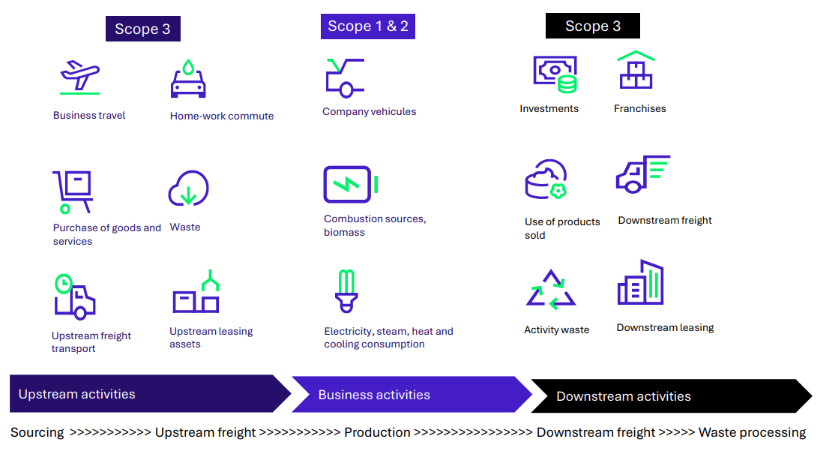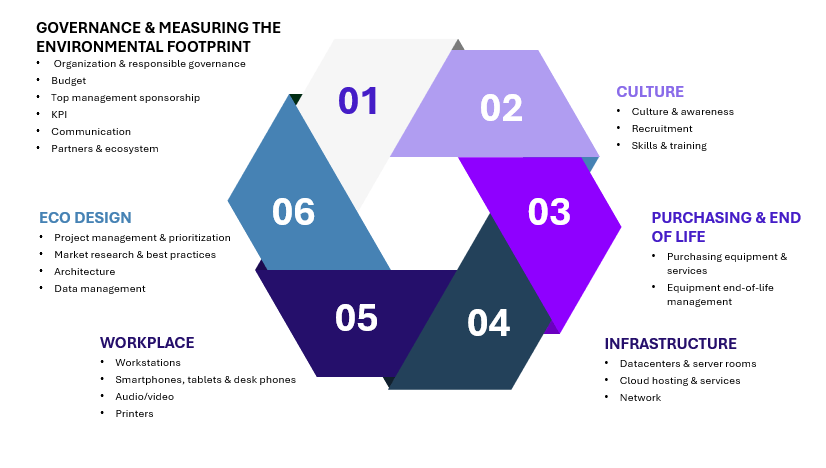Digital Sobriety: how to reduce the environmental impact of digital usage?
Published November 13, 2024
- CIO & CTO Advisory

Since COVID, public and private organizations have become aware of the digital sector’s impact on their environmental footprint. What are the key issues, questions, and dimensions to consider for embarking on a path toward reduction?
Global Push for Ambitious Emissions Cuts Intensifies
In the context of the Paris Climate Agreement, the urgency for the IT sector to address climate change is becoming increasingly critical. According to the Science Based Targets Initiative (SBTi), the digital sector must reduce its emissions by 45-62% between 2020 and 2030 to limit global warming to 1.5°C. Yet many decision-makers are unaware of the scale of this challenge, while the rapid development of technologies such as AI is exacerbating carbon emissions, making it even harder to meet climate targets. The urgency of action is underlined by alarming trends: digitalization currently accounts for between 2-4% of global emissions – with an annual growth rate of 2-7%.
These reduction challenges are significant, yet unfortunately, IT decision-makers in organizations still know far too little about them, even as the pressure continues to grow.
-
2-7% is the growth rate of annual emissions from the IT sector
-
-
Systemic Challenges Ahead
Beyond climate issues, digital sobriety is also important in order to mitigate tensions in other environmental dimensions:
The ecological transition requires a sharp increase in metal extraction (largely linked to electric vehicles). As digital technology is also a metal intensive sector, a policy of digital sobriety will help to reduce tensions linked to competing uses in the future.
Tensions linked to competing uses are already materializing, both in upstream digital equipment manufacturing activities, (eg.: droughts in 2021 and 2022 in Taiwan, and Soitec sites in denouncing the “water grab” by electronics manufacturers), and in terms of data center consumption (e.g.: water consumption at a Microsoft data center made headlines in the Netherlands in the summer of 2022).
The first conclusion to be drawn is simple: the lifespan of digital equipment should be extended as much as possible, and the construction of new digital equipment should be reduced as much as possible.
Pressure from Multiple Sides
In this context, organizations and their IT departments, particularly in Europe and the UK, are facing five key drivers and pressure points:
Increasingly concrete sustainability efforts are required by law, especially in the EU. The Corporate Sustainability Reporting Directive (CSRD) is one such regulation, requiring companies to report on a wide range of sustainability issues, including Scope 3 (see figure 1) emissions, where a significant portion of the IT footprint falls. Another key regulation is the EU Climate Law, which mandates that net greenhouse gas emissions must be reduced to zero by 2050. Additionally, the EU Taxonomy Regulation promotes sustainable investments and obliges companies to disclose how environmentally friendly their economic activities are. The Energy Efficiency Directive (EED) further prescribes energy savings in various sectors, including the IT industry. This legal framework puts pressure on the IT industry to develop and implement more sustainable practices.
A hot topic, as companies increasingly focus on sustainable sourcing strategies. Central to this is the development of decarbonization roadmaps specifically tailored to procurement, including IT services. These strategies aim to reduce GHG emissions across the entire supply chain, playing a crucial role in meeting climate targets. Procurement is key in selecting environmentally friendly suppliers and integrating sustainable practices throughout the sourcing process.
CIOs face the challenge of remaining cost-efficient despite the pressure to transform. The Gartner 2024 CIO and Technology Executive Survey predicts an increase in IT budgets of 2.4% to 5.2%, which is barely above the expected inflation rates of 2.4% to 7.4%. This situation calls for an increased focus on efficiency and innovation in the IT sector.
Purchasing decisions in companies are in general increasingly influenced by how “green” a company is. According to the Wavestone 2024 CSR Barometer, 88% of companies declare their CSR strategy is influenced by their customers. In France, for example 53% of ages 18-24 would choose a brand Involved In environment protection (43% all ages) . This pressure point creates a chain effect within the company that also influences IT departments.
In the intense competition for skilled talent, sustainability serves as a genuine competitive advantage for IT departments. Increasingly, individuals, particularly in Generation Z, seek purpose in their careers, where climate neutrality and future-oriented thinking are essential factors.

Figure 1: The Three Scopes of Carbon Footprint (source: Carbo)
Glossary / Differentiation of terms
The Need for a Strategic Digital Sobriety Approach
With growing pressures, more and more IT departments adopt a proactive stance on sustainability. Digital sobriety aims to minimize the environmental footprint of digital technologies by reducing energy consumption, extending the lifespan of IT equipment, and promoting sustainable practices across the IT lifecycle. This approach fosters a culture of resource-consciousness, balancing technological progress with ecological responsibility.
Although it can be challenging to quantify the exact impact of digital sobriety, Wavestone’s research shows that organizations implementing ambitious strategies can reduce their digital carbon footprint by 10-20% over three years. To meet both short-term regulatory requirements and long-term environmental goals, a structured digital sobriety roadmap is essential, providing clear actions to embed sustainability into IT operations and achieve meaningful emissions reductions.
Six Building Blocks to Develop a Pragmatic Digital Sobriety Roadmap
As more organizations develop CSR strategies, it’s important to align digital sobriety with these broader goals. The roadmap for digital sobriety includes six main areas, as shown in Figure 2 below.
It is essential to measure the ecological footprint of digitalization completely and to support decision-making. Efficient and scalable automation tools exist for this purpose, for example in the form of SaaS solutions (Software as a Service). In order to successfully implement this transformation, it must be supported by IT management (or ideally at COMEX level). For example, a digital sobriety officer can be appointed to ensure regular updates and comprehensive measurements.
Reducing the environmental impact of IT starts with user devices. Contrary to popular belief, user devices like laptops, smartphones, and monitors account for 65-90% of the digital carbon footprint – much more than data centers. This can be explained by the following factors: The average lifespan of end user devices in companies can be increased (as it has been done in France in recent years, from 3-4 years on average to 5 years currently in organizations). Worldwide, there are around 34 billion end devices for 4.1 billion users, which indicates a significant surplus.
Extending the lifespan of these devices is key to immediate emissions reductions. Refurbishing and reconditioning devices instead of disposing of them as electronic waste (WEEE) can also significantly cut down on emissions. This is important as the recycling of digital devices is very limited due to the low concentration of metals and the difficulty of recycling alloys. Companies can also introduce programs that redistribute or sell older computers and smartphones to employees instead of disposing them.
To promote digital sobriety, IT procurement contracts should include Green IT and CSR criteria in accordance with tenders including a significant weight of these criteria (at least 15% and ideally over 20%). CSR and decarbonization considerations should be included in strategic business relationships, procurement processes, and contractual clauses.
Global Push for Ambitious Emissions Cuts IntensifiesThe eco-design of digital services available to employees and customers is necessary to reduce the environmental footprint in the medium term and optimize resources throughout the supply chain in the long term. The implementation of eco-design makes it possible to optimize the use of devices, networks, and data centers and avoid unnecessary requirements. This far-reaching change affects both the IT department and the business units and requires a significant change process. All project stakeholders – from designers and developers to suppliers, architects, project managers and operators – need to be involved and trained on how to integrate eco-design into their daily work.
Covers the optimal use of IT infrastructure and data centers, as well as improving the flexibility of services. Key measures include improving the Power Usage Effectiveness (PUE), extending the lifespan of IT equipment in data centers, and increasing the mutualization rate of IT infrastructure. The geographical location of data centers is also crucial; they should be situated in regions with the lowest possible emissions from the electricity mix. Additionally, implementing GreenOps practices can significantly reduce energy consumption and emissions through more efficient utilization of IT resources. Cloud service providers are a key factor here and should support companies in choosing the best green strategy through transparent methodologies and dedicated carbon footprint tools.
Awareness anchored in the corporate culture is essential for the success of the digital sobriety. This means that all employees of a company must be sensitized to adapt their behavior and actively contribute to emissions efficiency. This should be a joint effort between CSR teams and IT departments. On the one hand, all employees need to understand why digital sobriety is important and how they can contribute to reducing the environmental footprint in their everyday lives. This requires awareness programs such as “Digital Collage” as well as training measures that raise awareness of sustainable practices. On the other hand, it is equally important that all IT stakeholders within the IT department – including IT buyers, developers, architects and project managers – receive targeted training. This training should address specific IT-related topics, such as the integration of Green IT criteria into procurement processes or the optimization of IT infrastructure.
In addition to general training courses, specialized offerings such as MOOCs, special workshops and certifications on digital sobriety can help to build expertise and provide concrete instructions for action. Comprehensive awareness education and training at both levels – company-wide and within IT departments – are crucial for bringing about a lasting change in corporate culture and successfully implementing the digital transformation.

Figure 2: The Six Building Blocks for a Roadmap to Digital Sobriety (Source: Wavestone)
A Dual Role: Meeting Today’s Standards while Shaping Tomorrow’s Sustainable Innovation
Green IT, or digital sobriety, is a crucial element of the IT sector’s response to climate change. By adopting a strategic approach and embedding sustainability across IT operations, organizations not only reduce their carbon footprint but can also meet regulatory demands, satisfy consumer and talent expectations, and improve cost efficiency. A well-structured Green IT roadmap, emphasizing governance, sustainable procurement, eco-design, infrastructure, and cultural shifts, ensures meaningful progress toward a greener digital landscape.
Yet, this journey also prompts a broader question: Can IT continue to innovate and play its part in the global shift toward sustainability? As technology evolves, the potential for IT to drive impactful, lasting change, in environmental responsibility could also define the sector’s legacy in building a sustainable future. More concretely IT for Green use cases should be prioritized over other digital use cases, while respecting the absolute reduction of GHG emissions from digital technology worldwide. A topic definitely worth tackling in a follow-up article.
As technology evolves, the ability of IT to drive lasting and significant changes in environmental responsibility could also define the sector’s posterity in building a sustainable future.
Authors
-

Benoit Durand
Senior Manager – France, Nantes
Wavestone
LinkedIn -

Christian Hildebrandt
Associate Partner – Munich
Wavestone
-

Marta Koscielak
Manager – London
Wavestone